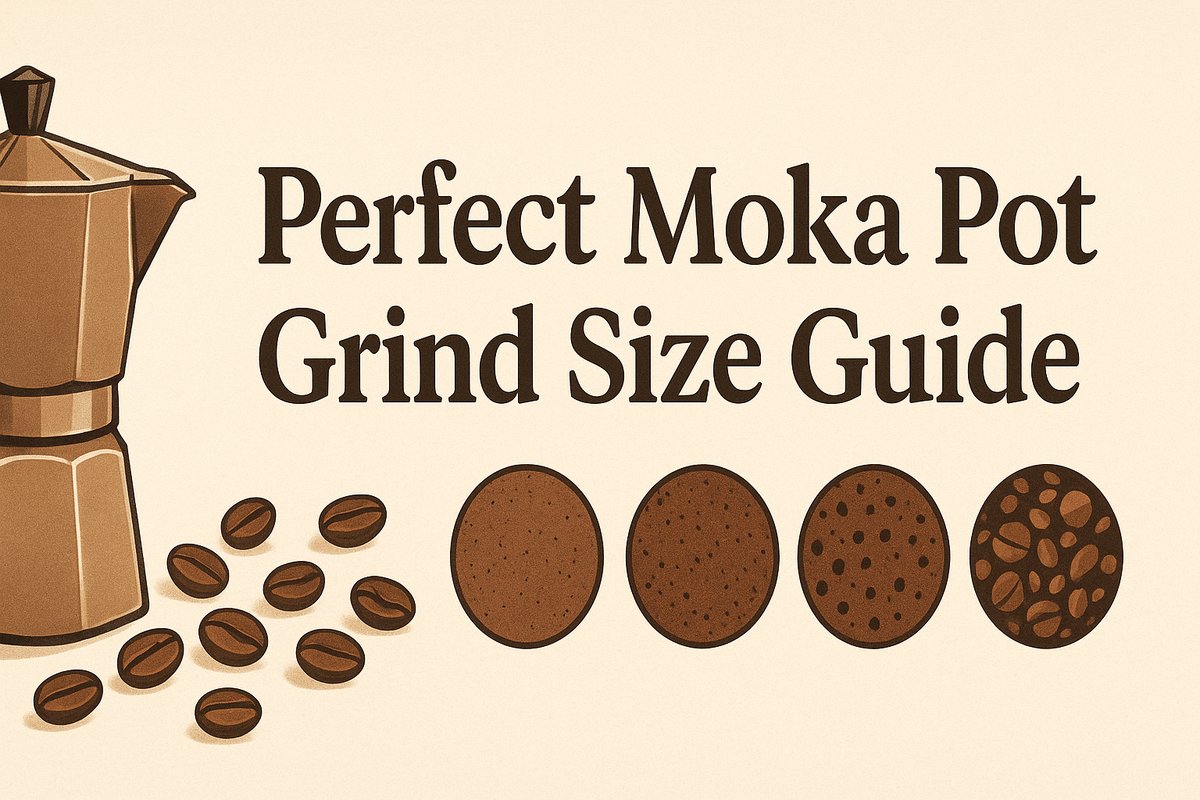Perfect Moka Pot Grind Size Guide
Master the key to great moka pot coffee: choosing the right grind size. Learn how to avoid over-extraction and under-extraction for perfect results every time.
David Rodriguez
Coffee Technician & Grind Specialist

The key to great moka pot coffee isn't just in the technique—it's in the grind. Too fine, and your coffee will be bitter and over-extracted. Too coarse, and you'll end up with weak, sour coffee that doesn't do justice to your beans. Getting the grind size right is perhaps the most critical factor in moka pot brewing success.
Unlike espresso machines that use 9 bars of pressure, moka pots generate only about 1.5 bars. This means the grind requirements are different, and understanding this difference is crucial for brewing excellent coffee.
The Quick Answer
Medium-fine grind is ideal for moka pot brewing—finer than drip coffee but coarser than espresso. Think table salt or slightly finer.
Grind Scale (1-10): Aim for a 6-7
(1 = Turkish, 5 = Espresso, 10 = French Press)
Visual Grind Size Guide
Too Fine
Like flour or powder
Creates excessive resistance, leading to over-extraction, bitterness, and potentially dangerous pressure buildup.
Results: Bitter, harsh, potentially clogged
Just Right
Like table salt
Perfect balance of extraction and flow rate. Allows proper pressure buildup while extracting optimal flavors.
Results: Balanced, rich, full-bodied
Too Coarse
Like coarse sea salt
Water flows too quickly through grounds, resulting in under-extraction and weak, sour coffee.
Results: Weak, sour, watery
Best Grinders for Moka Pot
The type of grinder you use significantly impacts your ability to achieve the perfect grind size consistency. Here's how different grinder types perform for moka pot brewing:
Burr Grinders
Best ChoiceProvide the most consistent grind size, which is crucial for even extraction. Both flat and conical burr grinders work well.
Blade Grinders
Budget OptionCan work for moka pot brewing but require careful timing and technique to achieve consistent results.
Manual Grinders
Excellent ValueHigh-quality manual burr grinders can produce excellent results at a fraction of the cost of electric burr grinders.
Troubleshooting Grind Issues
Problem: Coffee is bitter and harsh
Likely Cause: Grind is too fine, causing over-extraction
Solution: Use a coarser grind setting and reduce brewing time if possible
Problem: Coffee is weak and sour
Likely Cause: Grind is too coarse, causing under-extraction
Solution: Use a finer grind setting and ensure proper water temperature
Problem: No coffee coming out or very slow flow
Likely Cause: Grind is too fine, clogging the filter
Solution: Use a coarser grind and check that filter holes aren't blocked
Problem: Coffee sputters violently
Likely Cause: Heat too high or grind inconsistent
Solution: Reduce heat and ensure even grind distribution
Why Consistency Matters
Consistent grind size is more important than perfect grind size. Here's why:
Even Extraction
Uniform particle size ensures all coffee grounds extract at the same rate, preventing some grounds from over-extracting while others under-extract.
Proper Flow Rate
Consistent grind creates predictable resistance, allowing for optimal flow rate and pressure buildup in your moka pot.
Adjusting for Moka Pot Size
Different moka pot sizes may require slight grind adjustments due to varying pressure dynamics:
1-3 Cup Moka Pots
Slightly finer grind
Higher pressure per unit
6 Cup Moka Pots
Standard medium-fine
Balanced pressure
9+ Cup Moka Pots
Slightly coarser
Lower pressure per unit
Testing and Adjusting Your Grind
The 5-Step Grind Test
- 1 Start with a medium-fine grind (table salt consistency)
- 2 Brew using your standard technique and timing
- 3 Taste and evaluate: bitter = too fine, sour = too coarse
- 4 Adjust grind by one setting and repeat
- 5 Continue until you find your sweet spot
Grinding Fresh vs Pre-Ground
Grinding Fresh (Recommended)
- ✓ Maximum flavor and aroma preservation
- ✓ Complete control over grind size
- ✓ Ability to adjust for different beans
- ✓ Best possible moka pot results
Pre-Ground Coffee
- • Convenient but less control
- • Look for "moka pot" or "stovetop" labels
- • Use within 1-2 weeks of opening
- • Store in airtight container
Pro Tips for Perfect Grind
- ✓ Clean your grinder regularly for consistent results
- ✓ Weigh your coffee for repeatable results
- ✓ Keep notes on successful grind settings
- ✓ Consider water quality in your extraction
- ✓ Adjust grind for different coffee origins
- ✓ Don't be afraid to experiment
Finding Your Perfect Grind
The perfect moka pot grind size is more art than science. While medium-fine is the general rule, your specific moka pot, grinder, beans, and taste preferences all influence the ideal setting. The key is to start with our guidelines and then adjust based on taste.
Remember: consistency is more important than perfection. A slightly "wrong" grind size that's consistent will always produce better results than an "perfect" grind size that varies from cup to cup. Take notes, be patient, and enjoy the journey to your perfect moka pot coffee.